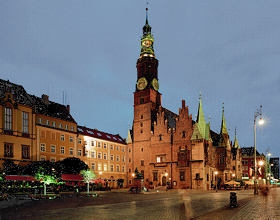The conference is organized by the Faculty of Chemistry, University of Wrocław. The conference will be held in the buildings belonging to the Faculty of Law (Uniwersytecka Street 7-10). The buildings are located in the centre of the city next to the heart of Wrocław’s historic Ostrów Tumski and within walking distance from other historic attractions such as the City Hall and Market Place. Arts and entertainment places such as the National Museum, Opera, Panorama Racławicka and several theatres are also nearby.
The City of Wrocław
Wrocław, the capital of Lower Silesia, is located in a valley of the Odra river, on the ancient trail linking the West and South with major cities of eastern and northern Europe. The local climate is moderate, winters are not very cold (average temperature in January is –2°C, the lowest temperature –15°C) and summers not too hot (average temperature +18°C, the highest temperature over +30°C).

Wrocław was first mentioned in the year 1000 when Bolesław the Brave (Bolesław Chrobry, 966-1025), King of Poland, established a bishopric here. In 1209 the town was referred to as civitas and the city was first located with Magdeburg statutes in 1241.
Today, the skyline of the city is still dominated by numerous church spires, including those of St. John the Baptist’s Cathedral, founded in the year 1000 and later rebuilt many times. There are many fine Gothic and Baroque structures. In 1945, the city was destroyed in about 70%; its two historical centres, the Old Town (Stare Miasto) and Cathedral Island (Ostrów Tumski), also suffered serious damage.
With the population of 650 000, Wrocław is today the fourth largest city in Poland. It is the industrial and cultural centre of the south-western part of the country and, with its 11 public and 8 private university level schools, the third largest academic centre in Poland.
University of Wrocław
On 20th July 1505, Ladislaus II Jagiełło, King of Bohemia and Hungary, signed the foundation deed of the University of Wrocław. Due to many obstacles, the University did not develop. In 1702, a small Jesuit Academy with Philolosophical and Theological Faculties was founded by the Emperor of Austria, Leopold I Habsburg, and named Leopoldian Academy. The Academy merged with the protestant Viadrina University which, after moving to Wrocław from Frankfurt-on-the-Oder, formed the Universitatis Literarum Wratislaviensis in 1811. The new University was developing very fast.

A new chapter in the history of the University opened in 1945, when a group of Polish scientists and students arrived in the almost completely ruined Wrocław. With great effort the collections of research books and equipment were built up. Excellent academic teachers agreed to work for the university, they usually came from the former Polish Universities in Lwów and Wilno, some of them were from other Universities. Thanks to all these efforts, University of Wrocław was opened in autumn 1945.
The Present University of Wrocław has 10 faculties: of Philology, Biotechnology, Earth and Environmental Sciences, Historical and Pedagogical Sciences, Law, Administration and Economy, Natural Sciences, Physics and Astronomy, Social Sciences, Chemistry, Mathematics and Computer Science. There are also 5 educational and research departments outside the structure of the faculties and 18 interfaculty departments. Some academic facilities are accessible to the public, for example the Botanical Garden, Museum of Natural History, Museum of Mineralogy and Museum of Geology. The University carries out teaching and research activities in all main academic fields. There are over 39 000 students. The number of professors and research staff is over 1 700. The University collaborates with many foreign research and academic institutions.
In 2002, the University of Wrocław celebrated the 300th anniversary of its foundation. For this anniversary the academic community of the University of Wrocław paid tribute to the diverse cultural and intellectual heritage that had shaped it. As an heir and upholder of many European traditions and cultures, the University of Wrocław preserves its unity and carries out its mission through the work of its academics and its general influence upon culture and education in Wrocław, Lower Silesia and Poland. Moreover, by means of co-operation with numerous other academic centres, it makes an important contribution to the culture and science of Europe and the world. Our anniversary became an opportunity to demonstrate our commitment to the humanistideas of openness, unity, tolerance, peace and understanding among nations and to promote the idea of Poland’s “return” to Europe.
Chemistry at the University

The Institute of Chemistry was founded in 1969 following the fusion of three independent units that had since 1954 existed within the framework of the Faculty of Mathematics, Physics and Chemistry as the Department of Inorganic Chemistry, Department of Organic Chemistry and Department of Physical Chemistry. The Institute of Chemistry was organized by its first Director, Professor Bogusława Jeżowska-Trzebiatowska, a talented manager and distinguished scientist. Soon, the Institute moved to a new place at 14 F. Joliot-Curie Street: the Main Building, housing research laboratories, was completed in 1970, the Laboratory (students’ laboratories) and Auditorium were finished later. In 1995 the Institute of Chemistry was transformed into the Faculty of Chemistry.
The Faculty of Chemistry provides the framework for chemistry research and teaching at the University of Wrocław. The Faculty’s research interests include:
- structural chemistry
- chemistry and dynamics of coordination compounds
- chemistry and physics of transition metals
- chemistry and stereochemistry of organic compounds
- intermolecular interactions
- molecular catalysis and reaction mechanisms
- biological chemistry and molecular biophysics
- electrochemistry
- chemistry and physics of new materials
- applied chemistry
The Faculty offers four undergraduate 3+2-years programs: in chemistry, environmental chemistry, computer-aided chemistry and in biological chemistry, all leading to the Master of Sciences degree. The Faculty also offers 4-years post-graduate programs leading to PhD degree (in Chemical Sciences). Such a program can be undertaken in any research group.
